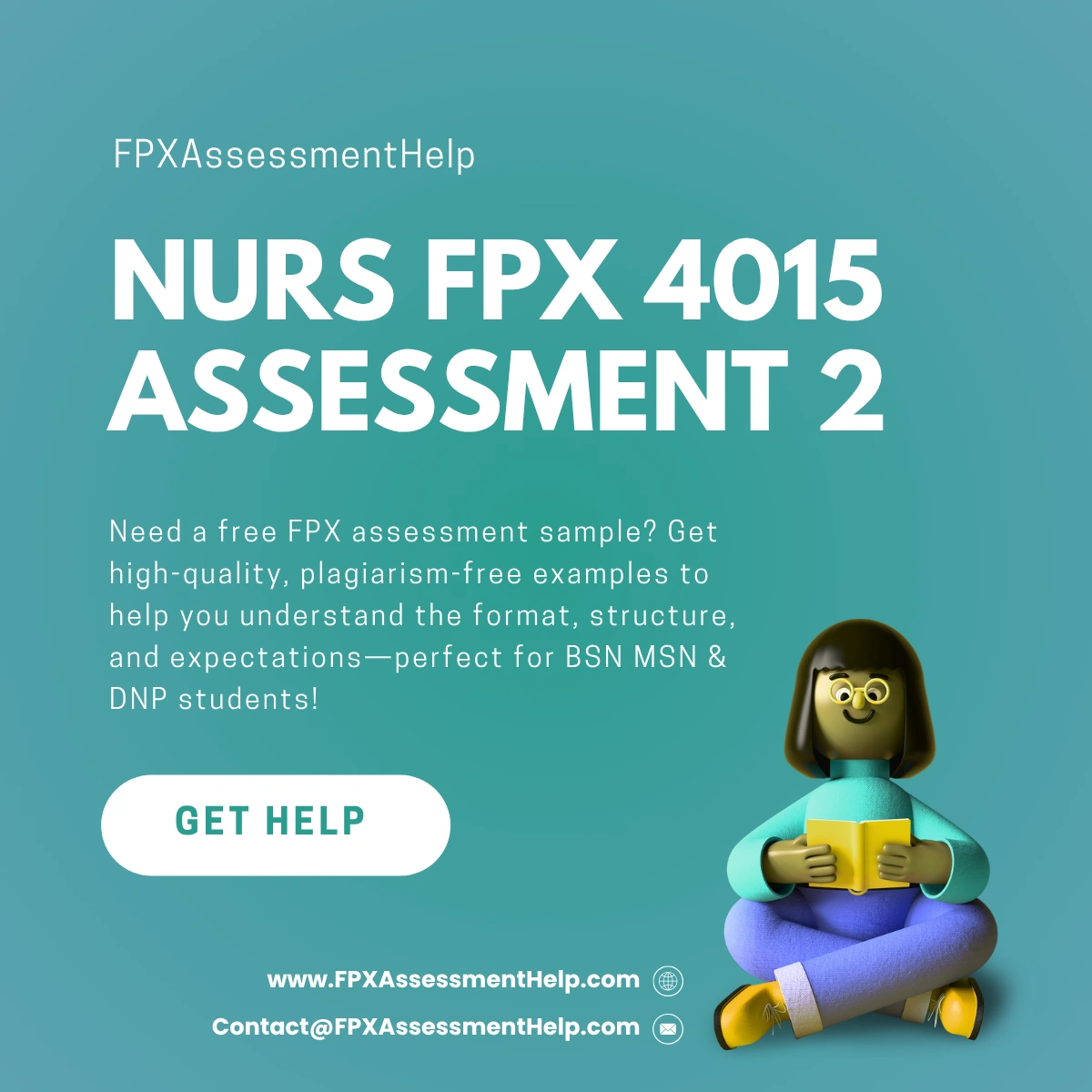NURS FPX 4015 Assessment 2 Enhancing Holistic Nursing Care with the 3Ps
Student Name
Capella University
NURS-FPX4015 Pathophysiology, Pharmacology, and Physical Assessment: A Holistic Approach to Patient-Centered Care
Prof. Name
Date
Enhancing Holistic Nursing Care With the 3Ps
Holistic nursing is a patient-centered approach that integrates the physical, emotional, spiritual, psychological, and social aspects of health. It emphasizes treating the whole person rather than isolating specific symptoms or diseases. According to the American Holistic Nurses Association, holistic nursing aims to “heal the whole person” through a balance of conventional practices and complementary therapies (Gripshi, 2021). These include therapeutic communication, empathy, mindfulness, and interventions such as yoga and guided imagery. By honoring the patient’s unique life experiences and environmental context, this model creates space for deeper connections and comprehensive healing.
The integration of holistic nursing within the framework of the 3Ps—Pathophysiology, Pharmacology, and Physical Assessment—strengthens the clinical foundation of care. Understanding disease mechanisms enables personalized interventions, pharmacologic knowledge ensures safe and effective medication use, and physical assessment anchors real-time patient evaluation. These components converge to provide a multifaceted care strategy that promotes both patient wellness and nurse satisfaction.
Benefits to Patients and Nurses
Holistic care positively influences both patients and healthcare providers. For patients, it leads to reduced stress levels, improved management of chronic illness, enhanced recovery, and overall better health-related quality of life (Hilcove et al., 2020; Ambushe et al., 2023). Mindfulness practices and relaxation techniques support emotional regulation, while personalized communication fosters trust and adherence to treatment. For nurses, engaging in holistic practices enhances their own well-being by reducing burnout and increasing job fulfillment. Self-care routines such as meditation, journaling, and peer support strengthen emotional resilience (Akilo, 2024). Holistic practice also promotes stronger clinical performance, as nurses are better prepared to educate and connect with patients.
| Benefits of Holistic Care | For Patients | For Nurses |
|---|---|---|
| Physical | Better symptom control, improved recovery | Greater confidence in clinical decisions |
| Emotional | Reduced anxiety, better emotional support | Decreased burnout and emotional fatigue |
| Social | Improved communication, shared decision-making | Enhanced teamwork and workplace culture |
| Spiritual | Support for individual beliefs and meaning-making | Deeper sense of purpose and compassion in practice |
Integrating the 3Ps in Clinical Nursing Practice
Pathophysiology in Clinical Reasoning
Pathophysiology is essential for nurses to understand disease progression and the physiological disruptions that manifest as clinical symptoms. This knowledge equips nurses to identify subtle changes, predict complications, and apply timely interventions. For example, in diabetes mellitus, recognizing that insulin resistance leads to sustained hyperglycemia helps nurses monitor for signs of vascular and neurological damage (Lima et al., 2022). This understanding informs both patient education and preventative strategies.
Moreover, a strong grasp of pathophysiology allows nurses to interpret emotional and psychological responses to illness. In COPD, for instance, reduced lung function not only causes breathlessness but may also contribute to anxiety and depression, limiting daily functioning (Aldhahi et al., 2023). Through this lens, nurses can provide care that acknowledges and addresses the full impact of chronic disease on a patient’s life.
In acute scenarios, such as sepsis, knowledge of the inflammatory cascade and resulting organ dysfunction helps nurses detect early warning signs like hypotension or mental status changes. These insights guide rapid interventions, including fluid resuscitation and administration of antibiotics, thereby improving survival rates (Kumar et al., 2024).
Pharmacology as a Therapeutic Tool
Pharmacology underpins the safe and effective use of medications across diverse patient populations. Nurses apply their knowledge of pharmacokinetics and pharmacodynamics to tailor drug regimens to individual needs, considering variables such as age, renal function, and potential drug interactions. For example, when treating hypertension in patients with compromised kidney function, careful use of ACE inhibitors is necessary to prevent electrolyte imbalances (Sturdivant & Allen-Thomas, 2023).
Pharmacology also intersects with psychological and socioeconomic dimensions. Patients taking SSRIs for depression may face emotional side effects, adherence issues, or challenges accessing medications due to cost or literacy limitations (Edinoff et al., 2021). Nurses serve as educators and advocates, providing simplified instructions, encouraging adherence, and connecting patients with financial resources or social services to ensure treatment continuity.
| Clinical Consideration | Example | Nursing Action |
|---|---|---|
| Renal Impairment | Adjust ACE inhibitors to avoid hyperkalemia | Monitor lab results, dose adjustments |
| Psychological Impact | Side effects of SSRIs (e.g., fatigue, weight gain) | Regular mood assessments, educate about expectations |
| Socioeconomic Barriers | Difficulty affording medications | Recommend alternatives, liaise with social services |
Physical Assessment as a Foundation for Care
Physical assessment is fundamental to nursing practice, enabling data collection that drives care planning and evaluation. Techniques such as inspection, palpation, percussion, and auscultation help detect abnormalities across various body systems. For instance, in cardiovascular assessments, auscultating for murmurs or checking for peripheral edema can uncover early signs of heart failure (Schwinger, 2021).
Ongoing assessments allow for real-time evaluation of intervention effectiveness. Nurses monitor indicators like respiratory rate, skin turgor, and pain scores to adapt treatment accordingly. Accurate assessments contribute to evidence-based, patient-centered care by aligning nursing actions with evolving clinical needs.
Applying the 3Ps in Clinical Scenarios
Managing Heart Failure in Acute Care
Heart failure is a prime example of integrating pathophysiology, pharmacology, and physical assessment. Pathophysiologically, impaired ventricular function reduces cardiac output and leads to fluid overload. Nurses assess for signs like crackles in the lungs, jugular vein distension, and weight gain. Pharmacologic interventions include diuretics and beta-blockers, requiring monitoring for hypotension and electrolyte shifts (Schwinger, 2021). Nurses also educate patients on dietary restrictions, promoting adherence and reducing rehospitalization risk.
| 3P Element | Clinical Focus | Nursing Role |
|---|---|---|
| Pathophysiology | Reduced ejection fraction, fluid accumulation | Monitor symptoms and predict decompensation |
| Pharmacology | Use of furosemide and metoprolol | Administer, assess effects, and manage side effects |
| Physical Assessment | Signs: edema, dyspnea, lung crackles | Perform and document ongoing assessments |
Coordinating COPD Care in Outpatient Settings
In COPD management, understanding airflow limitation caused by chronic inflammation informs patient evaluation and intervention. Nurses assess breathing patterns, auscultate lung sounds, and observe for fatigue and cyanosis. Medications such as albuterol and tiotropium are used to manage symptoms and reduce exacerbations. Nurses instruct on inhaler use, watch for adverse effects like oral candidiasis, and encourage smoking cessation (Gomes & Cheng, 2023). Holistic support improves patients’ physical and emotional adjustment to their condition.
Conclusion
Holistic nursing care, when enhanced by the integration of pathophysiology, pharmacology, and physical assessment, leads to well-rounded, patient-centered practice. These three pillars equip nurses with the tools to understand disease processes, ensure safe and personalized pharmacologic management, and perform effective clinical evaluations. The result is improved patient outcomes, greater nurse satisfaction, and more resilient healthcare systems. Embracing this integrated, holistic approach fosters compassion, adaptability, and evidence-based excellence in nursing practice.
References
Akilo, B. (2024). Reducing burnout and enhancing resilience of psychiatric nurses through self-care practices. University of New Hampshire Scholars’ Repository. https://scholars.unh.edu/scholarly_projects/111/
*Aldhahi, M. I., Baattaiah, B. A., Nazer, R. I., & Albarrati, A. (2023). Impact of psychological factors on functional performance among patients with chronic obstructive pulmonary disease. International Journal of Environmental Research and Public Health, 20(2), 1285. https://doi.org/10.3390/ijerph20021285
NURS FPX 4015 Assessment 2 Enhancing Holistic Nursing Care with the 3Ps
*Ambushe, S. A., Awoke, N., Demissie, B. W., & Tekalign, T. (2023). Holistic nursing care practice and associated factors among nurses in public hospitals of Wolaita Zone, South Ethiopia. BMC Nursing, 22(1). https://doi.org/10.1186/s12912-023-01517-0
*Edinoff, A. N., Akuly, H. A., Hanna, T. A., Ochoa, C. O., Patti, S. J., Ghaffar, Y. A., … & Kaye, A. M. (2021). Selective serotonin reuptake inhibitors and adverse effects: A narrative review. Neurology International, 13(3), 387–401. https://doi.org/10.3390/neurolint13030038
*Gomes, F., & Cheng, S.-L. (2023). Pathophysiology, therapeutic targets, and future therapeutic alternatives in COPD: Focus on the importance of the cholinergic system. Biomolecules, 13(3), 476. https://doi.org/10.3390/biom13030476
Gripshi, S. (2021). The importance of holistic nursing care. https://www.researchgate.net/profile/Silvana-Gripshi/publication/379994671_The_importance_of_holistic_nursing_care/links/662647fb43f8df018d1fb13e/The-importance-of-holistic-nursing-care.pdf
*Hilcove, K., Marceau, C., Thekdi, P., Larkey, L., Brewer, M. A., & Jones, K. (2020). Holistic nursing in practice: Mindfulness-based yoga as an intervention to manage stress and burnout. Journal of Holistic Nursing, 39(1), 089801012092158. https://doi.org/10.1177/0898010120921587
NURS FPX 4015 Assessment 2 Enhancing Holistic Nursing Care with the 3Ps
*Kumar, N. R., Balraj, T. A., Kempegowda, S. N., & Prashant, A. (2024). Multidrug-resistant sepsis: A critical healthcare challenge. Antibiotics, 13(1), 46. https://doi.org/10.3390/antibiotics13010046
*Lima, J. E. B. F., Moreira, N. C. S., & Sakamoto-Hojo, E. T. (2022). Mechanisms underlying the pathophysiology of type 2 diabetes: From risk factors to oxidative stress, metabolic dysfunction, and hyperglycemia. Mutation Research/Genetic Toxicology and Environmental Mutagenesis, 874–875, 503437. https://doi.org/10.1016/j.mrgentox.2021.503437
*Schwinger, R. H. G. (2021). Pathophysiology of heart failure. Cardiovascular Diagnosis and Therapy, 11(1), 263–276. https://doi.org/10.21037/cdt-20-302
Sturdivant, T., & Allen-Thomas, K. (2023). ACE inhibitors and ARBs. Nursing Made Incredibly Easy!, 21(1), 14–21. https://doi.org/10.1097/01.nme.0000899392.70376.a2





